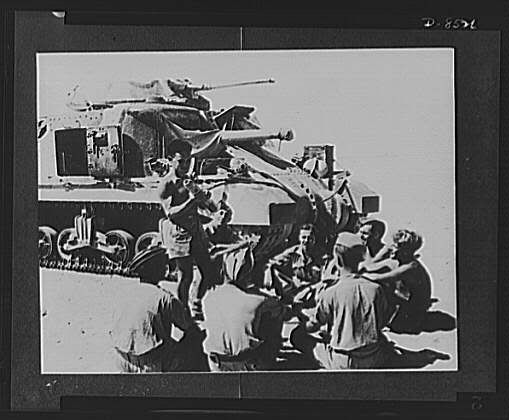
The title for the photograph explicitly tells us the relationship between the seven men. They are soldiers, equal, fighting for one cause. Even though the American is teaching the British soldiers, and thus seems to be the leader, this cannot be assumed. All seven of these men had been through the hell of modern warfare. They had seen the almost invincible Panzer tanks barreling toward them. They had seen their friends die in the deathtraps that were early Allied tanks. They had seen their shells ineffectively bounce off the Panzer’s thick armor. Only when we understand this historical context can even partially begin to understand the relationship these men share. The British are intently listening to the American because they know the information they learn in this crash course could one day save their lives. The American lovingly looks at the shell because he knows it can one day destroy a Panzer before it destroys him.
In analyzing the landscape, keeping to a strict definition will not be extremely beneficial. The landscape of the photograph consists of a flat, sunny desert and a tank. The tank is closer to a person in the photograph (see the analysis above) than an object. Analyzing the broader context of the landscape (i.e. the North African desert), however, is extremely beneficial.
Erwin Rommel, the German commander in Africa, hated the continent. It was hard on machines, men, and supplies. The Allies hated Africa as well for many of the same reasons, but had the added problem that the Germans were very skilled at desert warfare. This information adds a new level of meaning to the picture. Not only are the men in the picture soldiers, they are also desperate. Every man in the picture despises the hot days and cold nights, the sand, the sun, the endless dunes, the Germans, and even sometimes their own commanders. They simply wanted out, and they saw the new generation of tanks as the way to do it. The lighting of the picture also highlights this with the extremely bright sun distorting the image.
This picture does not really have any geography or structural types, especially if we count the tank as a person, as I am doing for this analysis. However, the historical context and the meaning it would have to the original audience is worth mentioning.
When the United States entered the war, the Americans suffered a series of humiliating losses. Outdated equipment, poor leadership, and inexperience plagued the American armies. These new tanks represented a change. This picture would cause a highly patriotic reaction in its original audience. This is especially true because it shows an American teaching British soldiers how to operate machinery. At the time, the British believed the Americans had no right to teach them how to fight a war which Britain had been fighting for over a year.
This photograph has many layers of emotion and feeling. The men show us desperate, determined soldiers. The photographer is intending to stir up patriotic feelings in his audience. Much of the meaning is lost today, but if we put ourselves in the context of the 1940s, we can begin to understand the argument of the photograph.
In analyzing the landscape, keeping to a strict definition will not be extremely beneficial. The landscape of the photograph consists of a flat, sunny desert and a tank. The tank is closer to a person in the photograph (see the analysis above) than an object. Analyzing the broader context of the landscape (i.e. the North African desert), however, is extremely beneficial.
Erwin Rommel, the German commander in Africa, hated the continent. It was hard on machines, men, and supplies. The Allies hated Africa as well for many of the same reasons, but had the added problem that the Germans were very skilled at desert warfare. This information adds a new level of meaning to the picture. Not only are the men in the picture soldiers, they are also desperate. Every man in the picture despises the hot days and cold nights, the sand, the sun, the endless dunes, the Germans, and even sometimes their own commanders. They simply wanted out, and they saw the new generation of tanks as the way to do it. The lighting of the picture also highlights this with the extremely bright sun distorting the image.
This picture does not really have any geography or structural types, especially if we count the tank as a person, as I am doing for this analysis. However, the historical context and the meaning it would have to the original audience is worth mentioning.
When the United States entered the war, the Americans suffered a series of humiliating losses. Outdated equipment, poor leadership, and inexperience plagued the American armies. These new tanks represented a change. This picture would cause a highly patriotic reaction in its original audience. This is especially true because it shows an American teaching British soldiers how to operate machinery. At the time, the British believed the Americans had no right to teach them how to fight a war which Britain had been fighting for over a year.
This photograph has many layers of emotion and feeling. The men show us desperate, determined soldiers. The photographer is intending to stir up patriotic feelings in his audience. Much of the meaning is lost today, but if we put ourselves in the context of the 1940s, we can begin to understand the argument of the photograph.
No comments:
Post a Comment